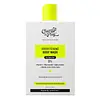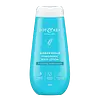What's inside
What's inside
 Key Ingredients
Key Ingredients

 Benefits
Benefits

 Concerns
Concerns

 Ingredients Side-by-side
Ingredients Side-by-side

Water
Skin ConditioningCocamidopropyl Betaine
CleansingSodium C14-16 Olefin Sulfonate
CleansingSorbitol
HumectantGlycerin
HumectantNiacinamide
SmoothingSodium Lauroyl Sarcosinate
CleansingPEG-150 Distearate
EmulsifyingGlycolic Acid
BufferingParfum
MaskingPEG-7 Glyceryl Cocoate
Emulsifying3-O-Ethyl Ascorbic Acid
Skin ConditioningAlpha-Arbutin
AntioxidantCeramide Ag
HumectantOryza Sativa Cera
Skin ConditioningPhospholipids
Skin ConditioningSphingolipids
EmollientGuar Hydroxypropyltrimonium Chloride
Skin ConditioningPropanediol
SolventMyrciaria Dubia Fruit Extract
Skin ConditioningPhenoxyethanol
PreservativeCI 19140
Cosmetic ColorantDisodium EDTA
Sodium Hydroxide
BufferingWater, Cocamidopropyl Betaine, Sodium C14-16 Olefin Sulfonate, Sorbitol, Glycerin, Niacinamide, Sodium Lauroyl Sarcosinate, PEG-150 Distearate, Glycolic Acid, Parfum, PEG-7 Glyceryl Cocoate, 3-O-Ethyl Ascorbic Acid, Alpha-Arbutin, Ceramide Ag, Oryza Sativa Cera, Phospholipids, Sphingolipids, Guar Hydroxypropyltrimonium Chloride, Propanediol, Myrciaria Dubia Fruit Extract, Phenoxyethanol, CI 19140, Disodium EDTA, Sodium Hydroxide
Water
Skin ConditioningCaprylic/Capric Triglyceride
MaskingGlycerin
HumectantCetearyl Alcohol
EmollientC12-20 Alkyl Glucoside
EmulsifyingButyrospermum Parkii Butter
Skin ConditioningGlyceryl Stearate
EmollientPEG-100 Stearate
Oryza Sativa Extract
AbsorbentJojoba Oil/Macadamia Seed Oil Esters
Skin ConditioningSqualene
EmollientPhytosteryl Macadamiate
Skin ConditioningPhytosterols
Skin ConditioningTocopherol
AntioxidantLaminaria Digitata Extract
Skin ProtectingCetyl-Pg Hydroxyethyl Palmitamide
Skin ConditioningCeramide EOP
Skin ConditioningCeramide Ns
Skin ConditioningCeramide NP
Skin ConditioningCeramide As
Skin ConditioningCeramide AP
Skin ConditioningHyaluronic Acid
HumectantDimethicone
EmollientPolyacrylamide
C13-14 Isoparaffin
EmollientLaureth-7
EmulsifyingCyclopentasiloxane
EmollientCetearyl Dimethicone
EmollientDimethicone/Vinyl Dimethicone Crosspolymer
Skin ConditioningXanthan Gum
EmulsifyingDisodium EDTA
BHT
AntioxidantPhenoxyethanol
PreservativeEthylhexylglycerin
Skin ConditioningOctenidine Hcl
AntimicrobialWater, Caprylic/Capric Triglyceride, Glycerin, Cetearyl Alcohol, C12-20 Alkyl Glucoside, Butyrospermum Parkii Butter, Glyceryl Stearate, PEG-100 Stearate, Oryza Sativa Extract, Jojoba Oil/Macadamia Seed Oil Esters, Squalene, Phytosteryl Macadamiate, Phytosterols, Tocopherol, Laminaria Digitata Extract, Cetyl-Pg Hydroxyethyl Palmitamide, Ceramide EOP, Ceramide Ns, Ceramide NP, Ceramide As, Ceramide AP, Hyaluronic Acid, Dimethicone, Polyacrylamide, C13-14 Isoparaffin, Laureth-7, Cyclopentasiloxane, Cetearyl Dimethicone, Dimethicone/Vinyl Dimethicone Crosspolymer, Xanthan Gum, Disodium EDTA, BHT, Phenoxyethanol, Ethylhexylglycerin, Octenidine Hcl
Ingredients Explained
These ingredients are found in both products.
Ingredients higher up in an ingredient list are typically present in a larger amount.
Disodium EDTA plays a role in making products more stable by aiding other preservatives.
It is a chelating agent, meaning it neutralizes metal ions that may be found in a product.
Disodium EDTA is a salt of edetic acid and is found to be safe in cosmetic ingredients.
Learn more about Disodium EDTAGlycerin is already naturally found in your skin. It helps moisturize and protect your skin.
A study from 2016 found glycerin to be more effective as a humectant than AHAs and hyaluronic acid.
As a humectant, it helps the skin stay hydrated by pulling moisture to your skin. The low molecular weight of glycerin allows it to pull moisture into the deeper layers of your skin.
Hydrated skin improves your skin barrier; Your skin barrier helps protect against irritants and bacteria.
Glycerin has also been found to have antimicrobial and antiviral properties. Due to these properties, glycerin is often used in wound and burn treatments.
In cosmetics, glycerin is usually derived from plants such as soybean or palm. However, it can also be sourced from animals, such as tallow or animal fat.
This ingredient is organic, colorless, odorless, and non-toxic.
Glycerin is the name for this ingredient in American English. British English uses Glycerol/Glycerine.
Learn more about GlycerinPhenoxyethanol is a preservative that has germicide, antimicrobial, and aromatic properties. Studies show that phenoxyethanol can prevent microbial growth. By itself, it has a scent that is similar to that of a rose.
It's often used in formulations along with Caprylyl Glycol to preserve the shelf life of products.
Water. It's the most common cosmetic ingredient of all. You'll usually see it at the top of ingredient lists, meaning that it makes up the largest part of the product.
So why is it so popular? Water most often acts as a solvent - this means that it helps dissolve other ingredients into the formulation.
You'll also recognize water as that liquid we all need to stay alive. If you see this, drink a glass of water. Stay hydrated!
Learn more about Water